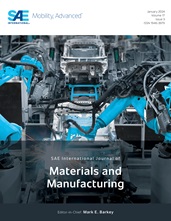The methods for improving the torsion stiffness of a pickup chassis frame were
discussed, including increasing the part thickness on frame, enlarging the cross
section of rails, and adding bulkhead feature inside the rails. Sizing
optimization was conducted to get the optimal thickness configuration for frame
parts and meet the siffness requirement. The cross section of frame rails was
parameterized and shape optimization was conduted to get the optimal rail cross
sections for stiffness improvement. Additional bulkheads were added to the frame
rails, and sizing optimization conducted to find the most effective bulkheads to
add and their optimal gauge. A material efficiency ratio μ is used to evaluate
the efficiency of a design change with respect to torsion stiffness. Among those
torsion improvement methods, adding bulkhead feature gives the highest material
efficiency ratio, but the stiffness improvement is very limited. Enlarging the
rail sections and increasing the part thickness can improve the torsion to over
9% while the material efficiency ratio is relatively low.
Simultaneous structural optimization was conducted combining above two and all
torsion improvement methods to obtain the most efficient lightweighting design.
For different design targets, the corresponding method combination was obtained
through optimization. For torsion improvement within 3.2%, adding bulkhead
feature is the most efficient design with high material efficiency ratio (μ >
7.936 kN-m/rad/kg). For improvement target 3.2%-5.4%, the design combining
adding bulkheads and enlarging the rail sections is most efficient with μ in
range of 3.861-7.936 kN-m/rad/kg. For improvement target 5.4%-10.3%, the design
combining all three improvement methods gives the optimal performance, with
material efficiency ratio μ in range of 2.333-3.861 kN-m/rad/kg. For target over
10.3%, above stiffness improvement methods do not offer an efficient solution
and the frame needs to be redesigned. This study gives guideline on adopting the
methods for stiffness improvement and achieving the optimal lightweigting
design.
